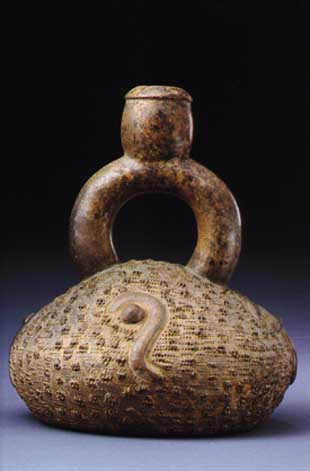|
The Chavin culture (900-200 B.C.) was a kind of a mother culture of the Andes. During the so-called starting period that preceded the Chavin stage, Peru was divided into numerous small cultural circles that came into contact very rarely.
The situation changed during the Chavin stage, as technological inventions connected with textile and metal work, artistic influences and exotic raw materials started to criss-cross the coastal and mountainous regions of central and northern Peru.
The Chavin culture has been named after the mountainous discovery site of Chavin de Huantar. The site is situated
at the junction of routes used for thousands of years, and the central location has surely contributed to the growth of the centre. The uniform nature of the Chavin period cannot be attributed to lively cultural contacts, solely. Religious motifs are important in Chavin art, and the spreading of this pictorial mode of expression has been interpreted as a sign of the growth of a religious cult that regarded Chavin de Huantar as its centre.
In a skillful manner, Chavin art combined motifs that had reigned already earlier in the art of the Andes with new inventions by creating a visually complex pictorial mode of expression. The most impressive artefacts are the tens of carve-decorated flagstones created to decorate the buildings of the temple area of Chavin de Huantar and the stone heads inlaid as wall ornaments. Typical of Chavin ceramics are flat-bottomed stirrup spout vessels, rows of recurring ornamental motifs, carved and stamp ornamentation plus the alternation of matt surface zones. Of metals gold especially had an important position, and some scholars have even said that it was the official metal of the Chavin cult.
Only a little is known about textiles in the Chavin culture, but it is known that at this time new texhniques of weaving were introduced.
|

This vessel represents a stirrup-spout vessel with a flat bottom, very typical of the Chavín culture.
© Museo del Banco Central de Reserva del Perú, Lima, Peru
(Cat. 1)
|

|
|

